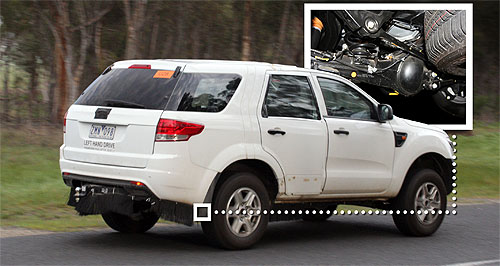Future models - Ford - EverestExclusive: Ford smooths out Everest rideScaling Everest: A Ford Australia engineer puts a disguised Everest SUV prototype through its paces in Victoria. Coil springs and possible self-levelling system on test bed for new Ford Everest SUV10 Sep 2013 FORD is aiming high with its rugged seven-seat Everest SUV under development in Australia, ditching the truck-like leaf-sprung rear end of the Ford Ranger ute donor vehicle for a smooth-riding coil-sprung set-up that might even include a self-levelling system on top-shelf variants. The major reworking of the rear end of the T6 platform for the wagon version – due out globally in late 2014 and in Australia in 2015 – does not include the full independent suspension that some pundits predicted, but almost everything else about the set-up has been refined for more car-like ride and handling. Our scrutiny shows an arrangement similar to that of the previous-generation Land Rover Discovery, with the live axle fixed by trailing control arms – also known as radius arms – that are clearly visible behind flimsy camouflage fringes fixed to the rear underside of the test “mules” spotted on public roads by GoAuto. The axle also features Watts linkages bolted to the middle of the differential housing for lateral location. Intriguingly, one of the Watts links seen by GoAuto has a connecting switch that, on vehicles such as the British-made Range Rover, controls self-levelling air suspension. As the Range Rover sags under a full load of passengers and cargo, the air springs inflate to put the vehicle back on an even keel, while also keeping the vehicle flat while cornering. However, there was no sign of air springs on this particular vehicle. Our photos show steel coil springs, which will most likely be the mainstay for the new range. The mounting points for the springs and dampers have shifted compared with Ranger, with dampers on the Everest fixed in front of the axle instead of behind. The whole set-up appears to be mounted in a cradle for easy fitting as one unit on the production line. For Australia, Everest will be made alongside Ranger at Ford’s joint-venture plant with Mazda in Thailand, but there is no suggestion Mazda will share the vehicle this time. The wagon is also likely to be built at other Ford Ranger plants around the world, almost certainly including those in Brazil and South Africa. Interestingly, the differential on the Everest test vehicle seen by GoAuto is centrally mounted, meaning it is unlikely to have a Discovery-style two-speed transfer box that requires offset differentials. However, the rear tailshaft has a slide arrangement – just like Land Rover – to allow for forward/aft movement in the rear axle. The slide mechanism is covered by a flexible rubber boot to protect it from grime. Ford staged the global reveal of the Victorian-developed Everest’s exterior at its multi-million-dollar ‘Go Further’ future product event in Sydney last month, but has been tight-lipped about the mechanicals and other specifications for the vehicle.  Left: Ford Everest revealed at the 'Go Further' future product event in Sydney last month. Left: Ford Everest revealed at the 'Go Further' future product event in Sydney last month.Vehicles seen by GoAuto have been powered by diesel engines, probably the 3.2-litre five-cylinder engine from the Ranger. However, other engines have not been ruled out, especially as the Everest will require versatility for a variety of markets through Asia, Africa and South America where it will be sold variously in left- and right-hand drive. Everest gets different sheetmetal to Ranger, penned at Ford’s design centre at Campbellfield, in Melbourne’s north, where the Ranger was also born ahead of its global debut in 2011. Everest crash testing and other engineering development work is well underway at Ford’s You Yangs proving ground near Geelong. Everest development was ramped up as the five-year Ranger project came to a close in 2011. As GoAuto reported back then, American Ford engineer Todd Hoevener transferred to Australia to head up the project after signing off on the latest Ford Explorer in Detroit. Everest prototypes on public roads have been cloaked with Ranger front panels and rear bodywork from Territory, but close scrutiny shows how the fabricators have grafted an extra 100mm or so between the back doors and rear canopy, indicating Everest will be substantially longer than Territory. Unlike the Falcon-based monocoque Territory, Everest will sit on the tough ladder chassis frame of the Ranger, with a similar double A-arm independent suspension on the front. A new interior layout unique to Everest has been designed, but it includes switch gear and other items common with fellow Ford models such as Focus. A third row of seats has been confirmed by Ford, folding away below the rear cargo floor. The full-sized spare wheel on prototypes is located under the rear of the vehicle. The Everest name might be new to Australia, but it has had a long history within Ford in Brazil where it is built off a light-commercial truck platform. The name for the new global model first came to light in a draft web page accidentally posted on Ford’s Australian website and then quickly taken down in 2011. Locally, the Everest will go head to head with General Motor’s similarly conceived Colorado 7, Isuzu MU-X, Nissan Pathfinder and Mitsubishi Challenger.  Read more13th of August 2013  First look: Ford’s Australian-developed Everest wagonRanger-based Everest SUV concept makes world debut as local R&D keeps busyEverest pricing
Motor industry news |
Click to shareFord modelsResearch Ford Everest pricing
Motor industry news |
















Facebook Twitter Instagram